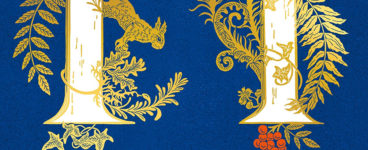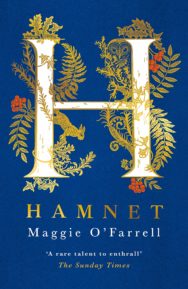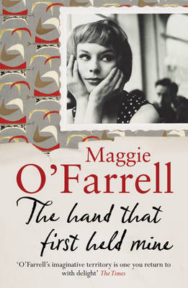‘Every life has its kernel, its hub, its epicentre, from which everything flows out, to which everything returns.’
David Robinson reads the much-anticipated new novel from Maggie O’ Farrell, and finds Hamnet an astonishing, moving and hugely impressive read.
Hamnet
By Maggie O’Farrell
Published by Tinder Press
Maggie O’Farrell was 16, going on 17, when she first heard about Hamnet. They were studying Hamlet in Mr Henderson’s English class at North Berwick High School when he mentioned that Shakespeare had named the play after his dead son. She wondered why, and over the next three decades carried on wondering. One day, she thought, there might be a novel in that.
There is. And even for such a phenomenally gifted storyteller, it’s her best yet.
Why? Let me count the ways. Look, for example, at how O’Farrell starts the story. A boy is running through an empty house in an as yet unnamed town, looking for his mother. He goes into every room, even his grandfather’s workshop, where he is normally forbidden to go, then the yard and the washhouses. So subtly that you hardly notice, he is named: Hamnet. We can see his urgency, but it is as if this is a scene with the sound turned down, so at first we don’t know the reasons for it. Instead, we get a spill of his most immediate memories: about how some kittens in the house were spared drowning, about how he and his sister had been teasing one of them with a pinecone, before Judith, his 11-year-old twin, felt ill and went off to bed. She lies there still, with what feels like a pair of quail’s eggs underneath the skin of her neck.
Tonally, this – as with so much of the rest of the novel – is both as beautifully descriptive and subtly detached as a Terrence Mallick film. Yet it’s more than that too. Because we, the readers, know that those bumps in Judith’s neck are the first sign of plague, and that Hamnet is desperately searching for his mother Agnes because she alone has the herbalist knowledge to effect a cure, provided it can be caught early enough. And we know what plague does to 11-year-old children. So even though we haven’t been formally told precisely where and when the story is taking place, we might suspect that we have already been told the whole novel, right there in the opening scene. We already half-know about Hamnet and Hamlet. What more is there to say?
O’Farrell’s task is to make us forget that half-knowledge, and make everything new again, as if death hadn’t yet come to the glover’s house in Henley Street, Statford. That’s why the boy’s father, a playwright, isn’t mentioned, because why should he be: he’s away in London, writing comedies. That other parental absence matters far more. ‘Every life has its kernel, its hub, its epicentre, from which everything flows out, to which everything returns,’ writes O’Farrell. ‘This moment is the absent mother’s: the boy, the empty house, deserted yard, the unheard cry.’ Agnes is, it turns out, a mile away from her children, trying to coax swarming bees back to her hives at her family farm.
Names are the first and most obvious way in which O’Farrell makes her story new again. That family farm is Hewlands, which is what Ann Hathaway’s cottage used to be called, Agnes is what Hathaway’s father used to call her, and according to Shakespeare expert Steven Greenblatt, quoted at the start in the novel, Hamnet and Hamlet were used interchangeably at the time. Shakespeare himself is never named, although his roles are: ‘Judith’s father’, ‘the Latin tutor’, ‘the glove-maker’s son’, ‘the playwright’, and so on. In his short biography of Shakespeare, Bill Bryson once noted that ‘he is the literary equivalent of an electron – forever there but not there’. He is more fleshed out than that here, but there’s still something missing too. There has to be. The novel demands it.
Shakespeare has made so many reappearances in fiction that there’s at least one whole book on the subject. Yet when you examine his recent fictional forms, most divide up neatly between the comic prefiguring of classic lines in his everyday life (Shakespeare in Love, Upstart Crow) and novelists (Anthony Burgess, Robert Nye) reimagining a life to fit their own interpretations of his work. What O’Farrell is attempting here doesn’t fit either paradigm; instead of mining his life for either punchlines or revelations, she has written a family tragedy of devastating – indeed, Shakespearean – depth, not least because she leaves him out of so much of the story.
Instead, the focus is on Agnes and her children – the twins Hamnet and Judith, and their elder sister Susannah – as they grow up in Henley Street. We see their home in Vermeer-like detail, along with its inhabitants: Agnes’s irascible, boozy father-in-law; her husband, yearning to escape the life of a small-town glover; the customers knocking at the street-facing window in search of the kind of folk-medicines and herbs she learnt all about growing up on the edge of the forest at Hewlands. For Agnes is a wise, witchy, free-spirited woman: uneducated maybe, but intuitive, seeing the future in her dreams and on strangers’ palms. She doesn’t care what people think about her, and ‘can cure anything, or cause anything’. No wonder her new mother-in-law thinks she has bewitched her glaikit Latin tutor son (‘All that education and not an ounce of sense’, her husband says). Because in a way she has.
It’s Agnes, not her younger husband, the unnamed playwright, who has agency here. It’s she who flouts her stepmother’s ban on marrying him by deliberately becoming pregnant. She who knows how the living need to be both reassured about and reassuring to the dead, and yet constantly vigilant against death’s approach. She who can see who will find happiness in life and who will not. She who will allow her husband, a bored Latin tutor, a bored glove-maker’s assistant, a potentially great writer, his freedom. She, not he, who will do most to try to save the twins from those quails’ eggs beneath the skin.
At the same time, this story of a child’s death breaks the heart, and O’Farrell’s writing fills it with wonder. How, you marvel, can a story told in the present tense, swoop back into the past and forward again so smoothly that you hardly notice? How can it be at one and the same time the most visual novel you could hope for and yet also reveal intentionality, memories, dreams and worries about the future with the same clarity? How can it have that precision, that level of detail, and yet also have the panache to follow plague-carrying fleas from a market in Alexandria to a box of beads in Stratford or to tiptoe into the afterlife? How – and both O’Farrell’s fiction and non-fiction has asked this question repeatedly – can words on a page help us to cope with loss?
The play’s the thing, Hamlet once said, working out his own particular strategy to do just that. But in the hands of a good writer, the novel can do the trick too. O’Farrell is such a writer, and this is such a book.
Hamnet by Maggie O’Farrell is published by Tinder Press, priced £20.
ALSO IN THIS ISSUE

 The Declaration of Arbroath
The Declaration of Arbroath
‘It is in truth not for glory, nor riches, nor honours that we fight, but for freedom alone, which n …

 David Robinson Reviews: Hamnet by Maggie O’ Farrell
David Robinson Reviews: Hamnet by Maggie O’ Farrell
‘Every life has its kernel, its hub, its epicentre, from which everything flows out, to which everyt …
















